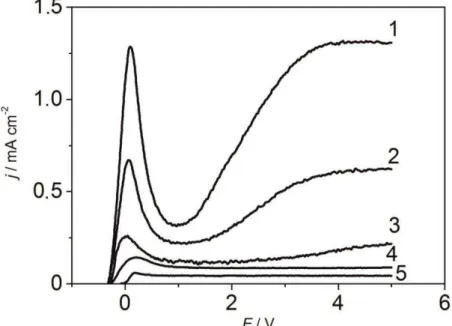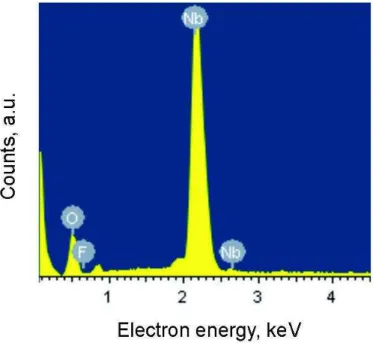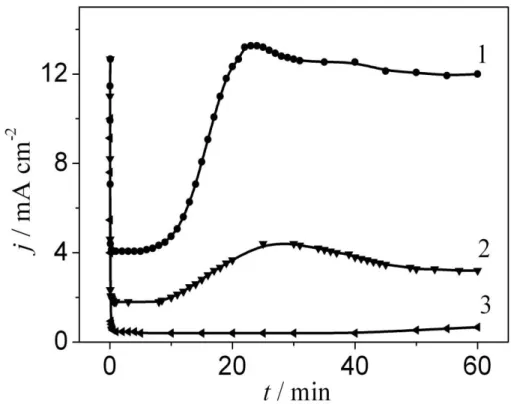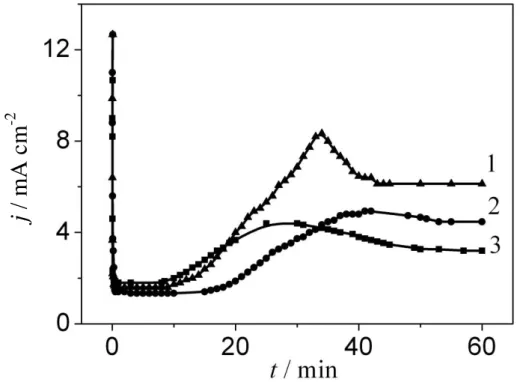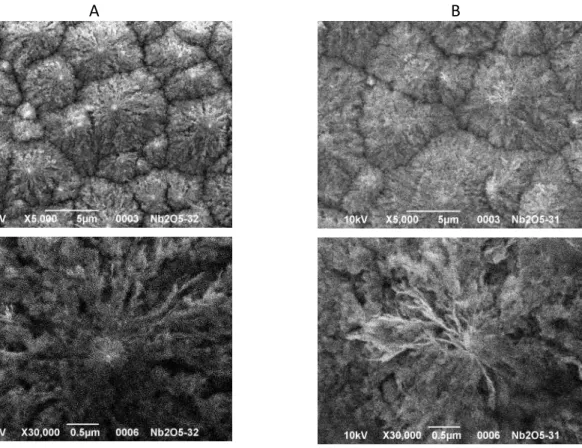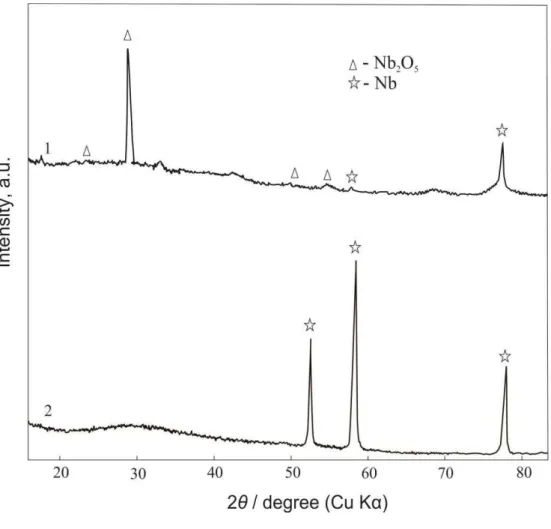Open Access: ISSN 1847-9286
www.jESE-online.org Original scientific paper
А odi for atio of a oporous r stalli e io iu o ide
LEONID SKATKOV
, LARISA LYASHOK*, VALERIY GOMOZOV*, IRINA
TOKAREVА*,
BORIS
ВAYRACHNIY*
Te h i al Divisio , PCB Argo Ltd., / “haul ha-Melekh str., 84797 Beer Sheva, Israel *Electrochemistry Depart e t, Natio al Te h i al U iversity KhPI , Fru ze str., Kharkov, Ukraine
Corresponding author: E-mail: sf-lskatkov@bezeqint.net; Tel.: +972 8 6482255
Received: February 16, 2014; Revised: April 6, 2014; Published: May 13, 2014
Abstract
The research results of anodic deposition of crystalline niobium oxide are presented in this work. The factors that have an impact on crystalline phase nucleation and its primary growth are revealed. Dependence of morphology and properties of nanoporous niobium oxide on modes of its formation is shown.
Keywords
Oxidation, anodic film, niobium, HF, crystallisation
1. Introduction
Increasing attention is being paid nowadays to the creation and studying of material properties that have nanometer structures. Anodic oxidation of valve metals (Al, Ti, Nb, Ta) is widely used for the formation of nanostructured oxide films. Self-organisation of nanoporous structures during electrochemical processing is completely revealed during the formation of porous anodic oxides of aluminium and titanium. These are distinguished by a high degree of sequence in the arrangement of pores and the possibility to operate in a variation of surface morphologies and thickness of the oxide film [1 2].
The resear hers’ ie s o the e ha is of u leatio a d the formation of crystalline structure of porous AOF niobium are inconsistent. Therefore, it is noted [9] that formation of the crystalline phase takes place under the influence of the internal tension that arises with a growth in oxide thickness. It is proposed in the work of Oikawa et al. [10] that formation of niobium oxide microcones has to be connected with non-uniform chemical dissolution of the anodic film during anodisation.
From our point of view, it is necessary to consider the chemical nature of niobium, which belongs to d-type elements, for understanding the nucleation and growth of the crystalline phase mechanism. When one electron has been released, it turns into an ion with empty external d-levels. As a result, the formed ion tries to achieve a stable electronic configuration, especially with oxygen and other non-metals. It is the existence of incomplete configurations of d-electrons that causes niobium to display a wide range of the valence states. The possibility of their existence is proved by thermodynamic calculations [11–13]; it is also shown that low valence oxides have to be on a metal/high valence oxide boundary. According to the authors [11–13], the transition zone cannot be considered as a certain plane-parallel layer between a metal and the high valence oxide. Local inhomogeneity on the metal surface, the border of grains, dislocation, admixture atoms and other structural and chemical defects are considered to be the centres of increased surface energy. At these centres, oxygen diffusion into metal is simplified and the primary formation of the lowest valence oxides is possible exactly here. As was shown in [7], films generated in potassium nitrate melt instead of forming an entire niobium pentoxide layer (as had first been suspected), creating a «sandwich» of Nb2O5, NbO2 and NbO phases (in the direction from oxide surface to niobium).
During discussion of the research results in this article, it was taken into account [13] that, in contrast to thermal crystallisation, no transformation of an amorphous into crystalline film occurred at niobium anodising.
The present work is aimed to identifying the factors defining primary formation of nanoporous crystalline in niobium oxide solutions containing the activator.
2. Experiment
2.1. Electrochemical investigations
AOF was formed in solutions of 1 M H2SO4 with the addition of various HF concentrations (0.5 – 2 M). Anodisation was carried out at room temperature in a volt-static mode and varying voltage in the range of 60 to 80 V. Platinum was used as a cathode electrode. Polarisation was carried out on potentiostat PI 50-1.1 with a scan rate of 10-2 V/s in potentiodynamic mode [14]. The copper-decoration method was used for the research of synthesised AOF conductivity. For this purpose, the cathode samples were polarised in a solution of 220 g/L CuSO4 + 60 g/L H2SO4. The copper plate worked as an anode, while niobium with the deposited oxide film functioned as a cathode.
2.2. SEM and X-ray investigation
3. Results and Discussion
Initially, niobium surface structure was considered as defective and containing natural oxide film that inherited defects after preparatory operations. In this regard, it was assumed that along the niobium surface at potential imposing, distribution of the electric field is non-uniform and velocity of the process' electrochemical growth and oxide dissolution on various sites of the surface are not identical, and depend on the degree of its deficiency and the composition of liquid facing a electric double layer. In defective sites, the dissolution process has to proceed at a high-speed rate followed with formation of pore seeds when field density is small, and crystalline phase seeds when a strong field is available.
For identification of the factors that have an impact on the generation of the crystalline phase at Nb2O5 formation, we considered the received anodic polarisation curves (Fig. 1). The size of the stationary potential of the niobium electrode in electrolyte with fluoride ions had a value that was more negative at fluoride concentration growth. Therefore, activation of the surface takes place without imposing the electric current when fluoride is present.
One maximum of current was observed on curves; this confirmed irreversibility of niobium oxide formation. Current peak value increased with the growth of fluoride ion concentration in electrolyte. A sharp rise of anode current and system transition into a passive condition was connected to the formation of the oxide monolayer of the higher oxidation state at the interface with electrolyte.
Figure 1. Polarisatio urves оf N i solutio s: 1 - H2SO4+ M F; 2 - H2SO4+ , M F;
3 - H2SO4+ , M F;4 - H2SO4+ , M F;5 - H2SO4.
The higher niobium oxides were insulators with a wide band gap and therefore had bad electronic conductivity; the low oxides and hydroxides functioned like semiconductors. Only stoichiometrical oxides acted as a barrier, with higher oxides being formed by means of full oxidation of the lowest oxides [12].
The multilayer niobium oxide formed when potentials were more positive than 1 V. If there was no activator in the solution (Fig. 1, curve 5), current practically did not depend on potential; thus, the AOF of the barrier type that had an amorphous structure was formed on niobium. The current grew in the system when concentration of the activator (fluoride ion) increased; thus, velocities of oxide formation and dissolution processes in active centres defined the geometry of porous amorphous anodic niobium oxide.
Being based on the analysis of theoretical regularities and experimental data on AOF formation on niobium, the argument can be made that its ionisation proceeds on the solid-phase multi surface mechanism [ ] for atio of io iu o ides of the lo est ale e. Оuter la ers, hi h were enriched with more oxygen, were the oxides of highest valence. Rate of niobium ionisation was controlled by the rate of mass transfer of oxygen-containing particles. The process of nanoporous oxide formation was defined by technological parameters of anodisation.
Results of the X-ray energy dispersive microanalyser (Fig. 2) confirmed that the synthesised films corresponded to the stoichiometric composition of Nb2O5 oxide, as concentration of elements (at. %) satisfied the ratio 2:5 in the received samples (Table 1).
Figure 2. EDS analysis of the niobium oxide film's surface.
Таble 1. Analysis of the chemical composition of the niobium oxide film.
Element Weight content, % Atomic content, %
Oxygen 29.39 70.02
Fluoride 0.65 1.31
Niobium 69.96 28.67
Totals 100.00 100.00
As mentioned above, AOF crystalline formation on niobium in electrolyte at room temperatures required an active and strong electric field, which was necessary for carrying out the process in a volt-static mode. Crystals were formed from grains under an amorphous film in an upper metal surface layer. Kinetics of crystalline phase formation in a volt-static mode was defined by the composition of electrolyte and temperature in the reaction zone.
While the crystal grew under the film, without destroying it, gradual current decreases were applied at the volt-static mode of AOF formation on niobium (Figs. 3, 4). After separate crystals broke the amorphous oxide, the current increased as long as the area occupied with a crystal phase grew while crystallisation developed. Crystals connected amongst themselves while they grew and then the current gradually began dropping.
Figure 3.Current vs. time during anodisation of Nb at 60 V in solution 1 M H2SO4
with addition of HF: 1 - 2 M; 2 - 1 M; 3 - 0.5 M
Velocity of the crystalline phase formation and growth processes increased with the activator concentration jump (Fig. 3). The authors of [12] offered to call the time from the start of anodisation to the current growth using the Nb-Nb2O5-electrolyte (MOE) system, as the incubatory period was connected with nucleation and the growth of crystals under the amorphous film of Nb2O5. After completion of the incubatory period in a chain of the MOE system, rapid increase of the current was observed (Figs. 3, 4), which can be explained due to contact of electrolyte with the crystal surface. While the crystallisation process was developing, the area occupied with the crystal phase increased and current growth in the MOE system chain slowed down.
Figure 4. Current vs. time during anodisation of Nb in solution 1 M H2SO4 + 1 M HFat:
1 - 80 V; 2 - 70 V; 3 - 60 V.
А B
Figure 5. SEM images of the surface (A) and cross-section (B) of anodic niobium oxide
synthesised during 5 h at V i solutio H2SO4 + 0. M F.
It can be seen that crystalline oxide increased electric conductivity (Fig.6, curve 3) in comparison with the amorphous porous structure of niobium oxide (Fig. 7) and the solid barrier oxide using the decoration method. As stated above, anodic niobium oxides of the crystalline structure had to possess electronic conductivity, in contrast to amorphous films. As can be seen in Fig. 6, allocation of copper on films of the amorphous structure practically did not occur in the range of 0.2 – 0.4 V. When cathode polarisation was 0.4 V and above, copper allocation on a sample with crystalline AOF (Fig. 6, curve 3) had a larger velocity. Therefore, resistance on the interfaces of solution CuSO4– AOF – niobium varied significantly for the received coatings.
j
/
m
A
c
m
A B
Figure 6. SEM images of the surface of anodic niobium oxide synthesised in solution
H2SO4+ M Fat V: A - 3 h; B - 5 h.
Figure 7. Current vs. potential during deposition of copper on anodic niobium oxide synthesised in:
1 - H2SO4, 60 V, 1 h; 2 - H2SO4 + 0.25 M HF, 20 V, 1 h; 3 - H2SO4 + 0.5 M HF, 60 V, 5 h.
Figure 8. XRD patterns from niobium AOF synthesised i solutio H2SO4 + 0. M F
at 60 V during: 1– 5 h; 2 - 1 h.
4. Conclusions
Based on the research conducted it can therefore be assumed that AOF formation on niobium proceeds on the solid-phase poly-surface mechanism by formation of low valence oxides, which are grains of the crystalline phase at formation of oxide monolayer. Growth of poly-layer crystalline niobium oxide was observed to take place under the amorphous film of Nb2O5. After completion of the incubatory period, growing crystals broke the barrier film and the crystallisation process developed on the entire surface of the sample. Predominant formation of nanoporous crystalline oxide of niobium took place in a volt-static mode and at strong field activity in electrolyte containing the activator. The superficial crystalline structure had a nanoporous structure. Its morphology depended on the fluoride ion concentration in the solution, voltage and anodisation time.
References
[1] S. Minagar, C. C. Berndt, J. Wanga, E. Ivanova, C. Wen, Acta Biomater. 8 (2012) 2875–2888. [2] P. Schmuki, Nanostructure Sci Tech. 3 (2009) 435–466.
[3] R. L. Karlinsey, Electrochem. Com. 7 (2005) 1190–1194.
[4] S. Yanga, H. Habazaki,T. Fujii, Y. Aoki, P. Skeldonb, G. E. Thompson, Electrochim. Acta 56 (2011) 7446–7453.
[5] R. A. Rani, A. S. Zoolfakara, J. Z. Oua, M. R. Fieldb, M. Austina, K. Kalantar-Zadeh, Sens. Actuators B 176 (2013) 149–156.
[7] L. Skatkov, V. Gomozov, Niobium: Chemical Properties, Applications and Environmental Effects, Nova Science Publ., New York ,USA, 2013, 123–136.
[8] J. E. Yoo, J. Park, G. Cha, J. Choi, Thin Sol. Films 531 (2013)583–587.
[9] J. Zhao, X. Wang, R. Xu, Y. Mi, Y. Li, Electrochem. Sol. State Lett. 10 (2007) C31–C33.
[10] Y. Oikawa, T. Minami, H. Mayama, K. Tsujii, K. Fushimi, Y. Aoki, P. Skeldon, G. E. Thompson, H. Habazaki, Acta Mat. 57 (2009) 3941–3946.
[11] R. Collongues, La Non-Stoechiometrie, Masson et Cie, Paris, France, 1971, p. 285. [12] L. Odynetz, Anodic Oxide Films, Nauka, Leningrad, USSR, 1990, p. 200.
[13] Ya. Kolotyrkin, Vestnik AN USSR 7 (1977) 73–80.
[14] V. Gomozov V., L. Skatkov, L. Liashok, B. Bayrachny, Sov. J. Appl. Chem. 62 (1989)1284– 1287.
© 2014 by the authors; licensee IAPC, Zagreb, Croatia. This article is an open-access article distributed under the terms and conditions of the Creative Commons Attribution license
